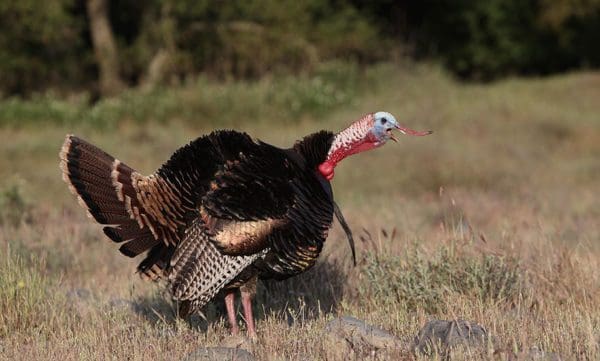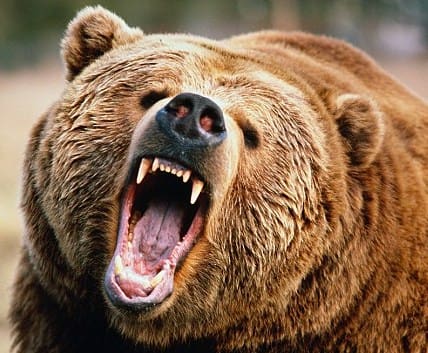
“Among the birds of North America, it could be argued that few rival the showmanship and vibrant plumage of the wild turkey,” the Texas Parks and Wildlife Department (TPWD) opines. “The unmistakable gobble and showy tail fan of the tom turkey indicate competition to pass on its genes to the next generation. This scene was nearly lost when . . .
over-hunting greatly reduced the number of Rio Grande wild turkeys (Meleagris gallopavo intermedia) in the late 1800s. By 1920, much of the population was extirpated over its original range and the number of turkeys in Texas fell to approximately 100,000 birds. At that time there were few restrictions on harvest and little understanding of the bird’s biology and habitat requirements.
Fast forward today: thanks to conservation efforts, Texas Rio Grande wild turkeys are thriving. In a 2015 article at texastribune.org, game bird specialist Jason Hardin estimated The Lone Star state is home to 500k Rio Grande wild turkeys and 8,000 Eastern wild turkeys.
The number of turkey hunters has steadily declined.
Since the 1987-88 hunting season — the peak period for turkey hunting in Texas — the number of turkey hunters and turkeys killed have both dropped drastically, according to Parks and Wildlife reports. More than 177,000 hunters killed 86,100 wild turkeys that season; in the 2014-15 hunting season, 84,700 turkey hunters killed 42,000 of the game birds.
TPWD estimates about 72k hunters now take part in Texas’ spring turkey season and take about 25,000 gobblers. (That’s only 2.7% of the entire Texas population.) Meanwhile, the money flowing to the department from arms and ammo sales continues .
Through the Federal Aid in Wildlife Restoration Act (popularly known as the Pittman-Robertson Act), an 11 percent excise tax on arms and ammo, the Texas Parks and Wildlife receives around of $10m per year.
More fun facts:
– Overall, hunting generates about $3b for the economy of Texas each year
– Members of the National Wild Turkey Federation can register their kills for $15. Kills are scored using a system that combines weight, length of spurs and beards
– According to NWTF the largest turkey ever harvested was in Montague County, Texas in 1993. The thunder chicken weighed 30.75 pounds with a total beard length of 9.68 inches. That’s a big ‘ole bird (average gobblers weigh 16-22 pounds).
– Highest-scoring turkey was in 2008 and weighed 25.25 pounds and had 6 beards! Total beard length was 55.8 inches. Bearded freak.
– If Wild Turkeys could smell, they’d be nearly impossible to hunt. The eyes and ears of a turkey make it one of the toughest of all Texas game animals. Their vision is the keenest among all Texas game animals. They are especially astute at pinpointing movement and can hone in on noises from a mile away.
– One of the most substantial and oldest winter turkey roosts is at South Llano River State Park near Junction.
– Size matters! Studies show that female turkeys prefer males with long snoods and that snood length can predict the winner of a competition between two males. Basically, turkeys get erections on their face.
– Turkeys can run at speeds of up to 25 miles per hour and fly as fast as 55 miles per hour.
– Benjamin Franklin wanted to make the turkey our national bird. “He is, (though a little vain and silly, it is true, but not the worse emblem for that,) a Bird of Courage, and would not hesitate to attack a grenadier of the British Guards, who should presume to invade his Farm Yard with a red Coat on.”




Always wondered. What’s the meat like from a wild turkey? Any turkey hunters out there?
Way more dark meat but otherwise a great tasting bird. A slightly different taste than a butterball due to their diet.
I would assume that like other game, their taste depends a lot on their diet. So a bird from central Oregon is going to taste a bit different than one from here on the west side.
We like our white meat chicken fried with cream gravy and hot rolls. Tender, juicy, and as God and Texas intended.
The breast is usually a little.. nuttier and more flavorful than domestic. The leg and thighs are darker and hard to use due to all the connective tissue. You’re gonna have to work to use that meat. Think pot pie or enchiladas. The breast on the other hand is excellent. You can bake it, pound it out marinate and grill it or slice into fingers and fry. The latter is a solid bet for anyone.
Wild turkey tastes completely different than the turkey you buy in the supermarket for Thanksgiving. Get over to Cabelas (they have a wild game menu) or order yourself some wild turkey jerky from the web. Its really delicious
“– Size matters! Studies show that female turkeys prefer males with long snoods and that snood length can predict the winner of a competition between two males.”
So, misandry is indeed a thing in the animal kingdom, just as it is with humans.
(Now I’m more depressed…)
*sob* 🙂
The last time I heard the phrase “get erections on their face”, I’m pretty sure we were talking about Spring Break.
The bird I’m curious about is goose. We had some farm raised for Christmas and it was great, but now I’m curious about what wild specimens taste like.
Already harvested a 28 pounder, and going back this afternoon. I love the early season, they’re super aggressive on the DSD Jake decoy (strategically placed near a couple AvianX hens), all you’ve got to do is get their attention and the gobblers come rushing in to attack. Hell, I had to shoot the gobbler to save the decoy!
Comments are closed.